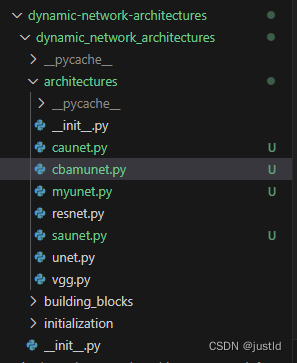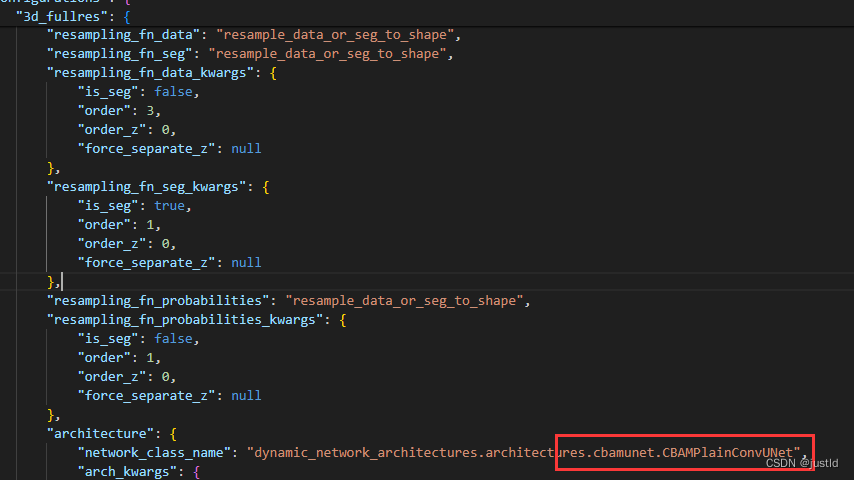nnUNet是一个自适应的深度学习框架,专为医学图像分割任务设计。以下是关于nnUNet的详细解释和特点:
自适应框架:nnUNet能够根据具体的医学图像分割任务自动调整模型结构、训练参数等,从而避免了繁琐的手工调参过程。
自动化流程:nnUNet包含了从数据预处理到模型训练、验证及测试的全流程自动化工具,大大简化了使用深度学习进行医学图像分割的复杂度。
自适应网络结构调整:根据输入数据集的特点,nnUNet能够自动选择和配置合适的网络深度、宽度等超参数,确保模型在复杂性和性能之间取得平衡。
Patch-Based Training and Inference:nnUNet使用基于patch级别的训练方法,通过滑窗的方式遍历整个图像进行训练。在推理阶段,也采用类似的方法来生成整个图像的分割结果。这种方法对于处理大尺寸图像或有限显存的情况非常有效。
集成学习与交叉验证:nnUNet还采用了交叉验证策略以最大程度利用有限的数据集,并结合集成学习技术来提高模型预测的稳定性和准确性。
此外,nnUNet还提供了丰富的文档和示例,帮助用户更好地了解和使用该框架。要使用nnUNet,用户需要安装Python和相应的深度学习框架,然后按照官方文档提供的步骤进行操作即可。总的来说,nnUNet是一个功能强大、易于使用的深度学习框架,特别适用于医学图像分割任务。它的自适应特性、自动化流程和先进的训练策略使得用户能够更高效地构建和训练模型,同时获得更好的性能表现。
之前已经介绍过nnunet的安装、使用以及自定义网络的教程,本文介绍在nnunet中加入CBAM的方法,阅读本文前,请确保已经掌握以下内容:
【nnUNetv2实践】一、nnUNetv2安装
【nnUNetv2实践】二、nnUNetv2快速入门-训练验证推理集成一条龙教程
【nnUNetv2进阶】三、nnUNetv2 自定义网络-发paper必会-CSDN博客
ChannelAttention的改进地址:
【nnUNetv2进阶】四、nnUNetv2 魔改网络-小试牛刀-加入注意力机制ChannelAttention-CSDN博客
【nnUNetv2进阶】五、nnUNetv2 魔改网络-小试牛刀-加入注意力机制SpatialAttention-CSDN博客

本文介绍在nnunet中加入CBAM的方法,CBAM是一种非常简单的注意力机制,非常适合魔改网络练手之用,更高级的魔改教程后续慢慢推出。
一、CBAM
CBAM的结构很简单,是Channel Attention和Spatial Attention的并行拼接,如下图:

其2D代码如下:
class ChannelAttention(nn.Module):def __init__(self, channels: int) -> None:super().__init__()self.pool = nn.AdaptiveAvgPool2d(1)self.fc = nn.Conv2d(channels, channels, 1, 1, 0, bias=True)self.act = nn.Sigmoid()def forward(self, x: torch.Tensor) -> torch.Tensor:return x * self.act(self.fc(self.pool(x)))class SpatialAttention(nn.Module):def __init__(self, kernel_size=7):super().__init__()assert kernel_size in (3, 7), 'kernel size must be 3 or 7'padding = 3 if kernel_size == 7 else 1self.cv1 = nn.Conv2d(2, 1, kernel_size, padding=padding, bias=False)self.act = nn.Sigmoid()def forward(self, x):return x * self.act(self.cv1(torch.cat([torch.mean(x, 1, keepdim=True), torch.max(x, 1, keepdim=True)[0]], 1)))class CBAM(nn.Module):def __init__(self, c1, kernel_size=7):super().__init__()self.channel_attention = ChannelAttention(c1)self.spatial_attention = SpatialAttention(kernel_size)def forward(self, x):return self.spatial_attention(self.channel_attention(x))
请注意:经测试CA和SA串行在nnunet中训练loss总是为nan,故将串行更改为并行。
二、nnunet加入CBAM
之前的教程已经提到过,nnunet的网络需要在dynamic-network-architectures中修改,并在数据集的plan中修改来实现自己的网络训练。
1、网络结构修改
在dynamic-network-architectures的architectures目录下新建cbamunet.py,如下图:

代码内容如下(CA和SA更改为并行,具体见代码):
from typing import Union, Type, List, Tupleimport torch
from dynamic_network_architectures.building_blocks.helper import convert_conv_op_to_dim
from dynamic_network_architectures.initialization.weight_init import InitWeights_He
from torch import nn
from torch.nn.modules.conv import _ConvNd
from torch.nn.modules.dropout import _DropoutNd
from dynamic_network_architectures.building_blocks.helper import maybe_convert_scalar_to_list, get_matching_pool_op
import numpy as np
from dynamic_network_architectures.building_blocks.helper import get_matching_convtranspclass CBAMPlainConvUNet(nn.Module):def __init__(self,input_channels: int,n_stages: int,features_per_stage: Union[int, List[int], Tuple[int, ...]],conv_op: Type[_ConvNd],kernel_sizes: Union[int, List[int], Tuple[int, ...]],strides: Union[int, List[int], Tuple[int, ...]],n_conv_per_stage: Union[int, List[int], Tuple[int, ...]],num_classes: int,n_conv_per_stage_decoder: Union[int, Tuple[int, ...], List[int]],conv_bias: bool = False,norm_op: Union[None, Type[nn.Module]] = None,norm_op_kwargs: dict = None,dropout_op: Union[None, Type[_DropoutNd]] = None,dropout_op_kwargs: dict = None,nonlin: Union[None, Type[torch.nn.Module]] = None,nonlin_kwargs: dict = None,deep_supervision: bool = False,nonlin_first: bool = False):"""nonlin_first: if True you get conv -> nonlin -> norm. Else it's conv -> norm -> nonlin"""super().__init__()if isinstance(n_conv_per_stage, int):n_conv_per_stage = [n_conv_per_stage] * n_stagesif isinstance(n_conv_per_stage_decoder, int):n_conv_per_stage_decoder = [n_conv_per_stage_decoder] * (n_stages - 1)assert len(n_conv_per_stage) == n_stages, "n_conv_per_stage must have as many entries as we have " \f"resolution stages. here: {n_stages}. " \f"n_conv_per_stage: {n_conv_per_stage}"assert len(n_conv_per_stage_decoder) == (n_stages - 1), "n_conv_per_stage_decoder must have one less entries " \f"as we have resolution stages. here: {n_stages} " \f"stages, so it should have {n_stages - 1} entries. " \f"n_conv_per_stage_decoder: {n_conv_per_stage_decoder}"self.encoder = CBAMPlainConvEncoder(input_channels, n_stages, features_per_stage, conv_op, kernel_sizes, strides,n_conv_per_stage, conv_bias, norm_op, norm_op_kwargs, dropout_op,dropout_op_kwargs, nonlin, nonlin_kwargs, return_skips=True,nonlin_first=nonlin_first)self.decoder = CBAMUNetDecoder(self.encoder, num_classes, n_conv_per_stage_decoder, deep_supervision,nonlin_first=nonlin_first)print('using cbam unet...')def forward(self, x):skips = self.encoder(x)return self.decoder(skips)def compute_conv_feature_map_size(self, input_size):assert len(input_size) == convert_conv_op_to_dim(self.encoder.conv_op), "just give the image size without color/feature channels or " \"batch channel. Do not give input_size=(b, c, x, y(, z)). " \"Give input_size=(x, y(, z))!"return self.encoder.compute_conv_feature_map_size(input_size) + self.decoder.compute_conv_feature_map_size(input_size)@staticmethoddef initialize(module):InitWeights_He(1e-2)(module)class CBAMPlainConvEncoder(nn.Module):def __init__(self,input_channels: int,n_stages: int,features_per_stage: Union[int, List[int], Tuple[int, ...]],conv_op: Type[_ConvNd],kernel_sizes: Union[int, List[int], Tuple[int, ...]],strides: Union[int, List[int], Tuple[int, ...]],n_conv_per_stage: Union[int, List[int], Tuple[int, ...]],conv_bias: bool = False,norm_op: Union[None, Type[nn.Module]] = None,norm_op_kwargs: dict = None,dropout_op: Union[None, Type[_DropoutNd]] = None,dropout_op_kwargs: dict = None,nonlin: Union[None, Type[torch.nn.Module]] = None,nonlin_kwargs: dict = None,return_skips: bool = False,nonlin_first: bool = False,pool: str = 'conv'):super().__init__()if isinstance(kernel_sizes, int):kernel_sizes = [kernel_sizes] * n_stagesif isinstance(features_per_stage, int):features_per_stage = [features_per_stage] * n_stagesif isinstance(n_conv_per_stage, int):n_conv_per_stage = [n_conv_per_stage] * n_stagesif isinstance(strides, int):strides = [strides] * n_stagesassert len(kernel_sizes) == n_stages, "kernel_sizes must have as many entries as we have resolution stages (n_stages)"assert len(n_conv_per_stage) == n_stages, "n_conv_per_stage must have as many entries as we have resolution stages (n_stages)"assert len(features_per_stage) == n_stages, "features_per_stage must have as many entries as we have resolution stages (n_stages)"assert len(strides) == n_stages, "strides must have as many entries as we have resolution stages (n_stages). " \"Important: first entry is recommended to be 1, else we run strided conv drectly on the input"stages = []for s in range(n_stages):stage_modules = []if pool == 'max' or pool == 'avg':if (isinstance(strides[s], int) and strides[s] != 1) or \isinstance(strides[s], (tuple, list)) and any([i != 1 for i in strides[s]]):stage_modules.append(get_matching_pool_op(conv_op, pool_type=pool)(kernel_size=strides[s], stride=strides[s]))conv_stride = 1elif pool == 'conv':conv_stride = strides[s]else:raise RuntimeError()stage_modules.append(CBAMStackedConvBlocks(n_conv_per_stage[s], conv_op, input_channels, features_per_stage[s], kernel_sizes[s], conv_stride,conv_bias, norm_op, norm_op_kwargs, dropout_op, dropout_op_kwargs, nonlin, nonlin_kwargs, nonlin_first))stages.append(nn.Sequential(*stage_modules))input_channels = features_per_stage[s]self.stages = nn.Sequential(*stages)self.output_channels = features_per_stageself.strides = [maybe_convert_scalar_to_list(conv_op, i) for i in strides]self.return_skips = return_skips# we store some things that a potential decoder needsself.conv_op = conv_opself.norm_op = norm_opself.norm_op_kwargs = norm_op_kwargsself.nonlin = nonlinself.nonlin_kwargs = nonlin_kwargsself.dropout_op = dropout_opself.dropout_op_kwargs = dropout_op_kwargsself.conv_bias = conv_biasself.kernel_sizes = kernel_sizesdef forward(self, x):ret = []for s in self.stages:x = s(x)ret.append(x)if self.return_skips:return retelse:return ret[-1]def compute_conv_feature_map_size(self, input_size):output = np.int64(0)for s in range(len(self.stages)):if isinstance(self.stages[s], nn.Sequential):for sq in self.stages[s]:if hasattr(sq, 'compute_conv_feature_map_size'):output += self.stages[s][-1].compute_conv_feature_map_size(input_size)else:output += self.stages[s].compute_conv_feature_map_size(input_size)input_size = [i // j for i, j in zip(input_size, self.strides[s])]return outputclass CBAMUNetDecoder(nn.Module):def __init__(self,encoder: Union[CBAMPlainConvEncoder],num_classes: int,n_conv_per_stage: Union[int, Tuple[int, ...], List[int]],deep_supervision,nonlin_first: bool = False,norm_op: Union[None, Type[nn.Module]] = None,norm_op_kwargs: dict = None,dropout_op: Union[None, Type[_DropoutNd]] = None,dropout_op_kwargs: dict = None,nonlin: Union[None, Type[torch.nn.Module]] = None,nonlin_kwargs: dict = None,conv_bias: bool = None):"""This class needs the skips of the encoder as input in its forward.the encoder goes all the way to the bottleneck, so that's where the decoder picks up. stages in the decoderare sorted by order of computation, so the first stage has the lowest resolution and takes the bottleneckfeatures and the lowest skip as inputsthe decoder has two (three) parts in each stage:1) conv transpose to upsample the feature maps of the stage below it (or the bottleneck in case of the first stage)2) n_conv_per_stage conv blocks to let the two inputs get to know each other and merge3) (optional if deep_supervision=True) a segmentation output Todo: enable upsample logits?:param encoder::param num_classes::param n_conv_per_stage::param deep_supervision:"""super().__init__()self.deep_supervision = deep_supervisionself.encoder = encoderself.num_classes = num_classesn_stages_encoder = len(encoder.output_channels)if isinstance(n_conv_per_stage, int):n_conv_per_stage = [n_conv_per_stage] * (n_stages_encoder - 1)assert len(n_conv_per_stage) == n_stages_encoder - 1, "n_conv_per_stage must have as many entries as we have " \"resolution stages - 1 (n_stages in encoder - 1), " \"here: %d" % n_stages_encodertranspconv_op = get_matching_convtransp(conv_op=encoder.conv_op)conv_bias = encoder.conv_bias if conv_bias is None else conv_biasnorm_op = encoder.norm_op if norm_op is None else norm_opnorm_op_kwargs = encoder.norm_op_kwargs if norm_op_kwargs is None else norm_op_kwargsdropout_op = encoder.dropout_op if dropout_op is None else dropout_opdropout_op_kwargs = encoder.dropout_op_kwargs if dropout_op_kwargs is None else dropout_op_kwargsnonlin = encoder.nonlin if nonlin is None else nonlinnonlin_kwargs = encoder.nonlin_kwargs if nonlin_kwargs is None else nonlin_kwargs# we start with the bottleneck and work out way upstages = []transpconvs = []seg_layers = []for s in range(1, n_stages_encoder):input_features_below = encoder.output_channels[-s]input_features_skip = encoder.output_channels[-(s + 1)]stride_for_transpconv = encoder.strides[-s]transpconvs.append(transpconv_op(input_features_below, input_features_skip, stride_for_transpconv, stride_for_transpconv,bias=conv_bias))# input features to conv is 2x input_features_skip (concat input_features_skip with transpconv output)stages.append(CBAMStackedConvBlocks(n_conv_per_stage[s-1], encoder.conv_op, 2 * input_features_skip, input_features_skip,encoder.kernel_sizes[-(s + 1)], 1,conv_bias,norm_op,norm_op_kwargs,dropout_op,dropout_op_kwargs,nonlin,nonlin_kwargs,nonlin_first))# we always build the deep supervision outputs so that we can always load parameters. If we don't do this# then a model trained with deep_supervision=True could not easily be loaded at inference time where# deep supervision is not needed. It's just a convenience thingseg_layers.append(encoder.conv_op(input_features_skip, num_classes, 1, 1, 0, bias=True))self.stages = nn.ModuleList(stages)self.transpconvs = nn.ModuleList(transpconvs)self.seg_layers = nn.ModuleList(seg_layers)def forward(self, skips):"""we expect to get the skips in the order they were computed, so the bottleneck should be the last entry:param skips::return:"""lres_input = skips[-1]seg_outputs = []for s in range(len(self.stages)):x = self.transpconvs[s](lres_input)x = torch.cat((x, skips[-(s+2)]), 1)x = self.stages[s](x)if self.deep_supervision:seg_outputs.append(self.seg_layers[s](x))elif s == (len(self.stages) - 1):seg_outputs.append(self.seg_layers[-1](x))lres_input = x# invert seg outputs so that the largest segmentation prediction is returned firstseg_outputs = seg_outputs[::-1]if not self.deep_supervision:r = seg_outputs[0]else:r = seg_outputsreturn rdef compute_conv_feature_map_size(self, input_size):"""IMPORTANT: input_size is the input_size of the encoder!:param input_size::return:"""# first we need to compute the skip sizes. Skip bottleneck because all output feature maps of our ops will at# least have the size of the skip above that (therefore -1)skip_sizes = []for s in range(len(self.encoder.strides) - 1):skip_sizes.append([i // j for i, j in zip(input_size, self.encoder.strides[s])])input_size = skip_sizes[-1]# print(skip_sizes)assert len(skip_sizes) == len(self.stages)# our ops are the other way around, so let's match things upoutput = np.int64(0)for s in range(len(self.stages)):# print(skip_sizes[-(s+1)], self.encoder.output_channels[-(s+2)])# conv blocksoutput += self.stages[s].compute_conv_feature_map_size(skip_sizes[-(s+1)])# trans convoutput += np.prod([self.encoder.output_channels[-(s+2)], *skip_sizes[-(s+1)]], dtype=np.int64)# segmentationif self.deep_supervision or (s == (len(self.stages) - 1)):output += np.prod([self.num_classes, *skip_sizes[-(s+1)]], dtype=np.int64)return outputclass CBAMStackedConvBlocks(nn.Module):def __init__(self,num_convs: int,conv_op: Type[_ConvNd],input_channels: int,output_channels: Union[int, List[int], Tuple[int, ...]],kernel_size: Union[int, List[int], Tuple[int, ...]],initial_stride: Union[int, List[int], Tuple[int, ...]],conv_bias: bool = False,norm_op: Union[None, Type[nn.Module]] = None,norm_op_kwargs: dict = None,dropout_op: Union[None, Type[_DropoutNd]] = None,dropout_op_kwargs: dict = None,nonlin: Union[None, Type[torch.nn.Module]] = None,nonlin_kwargs: dict = None,nonlin_first: bool = False):""":param conv_op::param num_convs::param input_channels::param output_channels: can be int or a list/tuple of int. If list/tuple are provided, each entry is forone conv. The length of the list/tuple must then naturally be num_convs:param kernel_size::param initial_stride::param conv_bias::param norm_op::param norm_op_kwargs::param dropout_op::param dropout_op_kwargs::param nonlin::param nonlin_kwargs:"""super().__init__()if not isinstance(output_channels, (tuple, list)):output_channels = [output_channels] * num_convsself.convs = nn.Sequential(ConvDropoutNormReLU(conv_op, input_channels, output_channels[0], kernel_size, initial_stride, conv_bias, norm_op,norm_op_kwargs, dropout_op, dropout_op_kwargs, nonlin, nonlin_kwargs, nonlin_first),*[ConvDropoutNormReLU(conv_op, output_channels[i - 1], output_channels[i], kernel_size, 1, conv_bias, norm_op,norm_op_kwargs, dropout_op, dropout_op_kwargs, nonlin, nonlin_kwargs, nonlin_first)for i in range(1, num_convs-1)],CBAM(conv_op, output_channels[-2], output_channels[-1], kernel_size, 1, conv_bias, norm_op,norm_op_kwargs, dropout_op, dropout_op_kwargs, nonlin, nonlin_kwargs, nonlin_first))self.act = nonlin(**nonlin_kwargs)self.output_channels = output_channels[-1]self.initial_stride = maybe_convert_scalar_to_list(conv_op, initial_stride)def forward(self, x):out = self.convs(x)out = self.act(out)return outdef compute_conv_feature_map_size(self, input_size):assert len(input_size) == len(self.initial_stride), "just give the image size without color/feature channels or " \"batch channel. Do not give input_size=(b, c, x, y(, z)). " \"Give input_size=(x, y(, z))!"output = self.convs[0].compute_conv_feature_map_size(input_size)size_after_stride = [i // j for i, j in zip(input_size, self.initial_stride)]for b in self.convs[1:]:output += b.compute_conv_feature_map_size(size_after_stride)return outputclass ConvDropoutNormReLU(nn.Module):def __init__(self,conv_op: Type[_ConvNd],input_channels: int,output_channels: int,kernel_size: Union[int, List[int], Tuple[int, ...]],stride: Union[int, List[int], Tuple[int, ...]],conv_bias: bool = False,norm_op: Union[None, Type[nn.Module]] = None,norm_op_kwargs: dict = None,dropout_op: Union[None, Type[_DropoutNd]] = None,dropout_op_kwargs: dict = None,nonlin: Union[None, Type[torch.nn.Module]] = None,nonlin_kwargs: dict = None,nonlin_first: bool = False):super(ConvDropoutNormReLU, self).__init__()self.input_channels = input_channelsself.output_channels = output_channelsstride = maybe_convert_scalar_to_list(conv_op, stride)self.stride = stridekernel_size = maybe_convert_scalar_to_list(conv_op, kernel_size)if norm_op_kwargs is None:norm_op_kwargs = {}if nonlin_kwargs is None:nonlin_kwargs = {}ops = []self.conv = conv_op(input_channels,output_channels,kernel_size,stride,padding=[(i - 1) // 2 for i in kernel_size],dilation=1,bias=conv_bias,)ops.append(self.conv)if dropout_op is not None:self.dropout = dropout_op(**dropout_op_kwargs)ops.append(self.dropout)if norm_op is not None:self.norm = norm_op(output_channels, **norm_op_kwargs)ops.append(self.norm)if nonlin is not None:self.nonlin = nonlin(**nonlin_kwargs)ops.append(self.nonlin)if nonlin_first and (norm_op is not None and nonlin is not None):ops[-1], ops[-2] = ops[-2], ops[-1]self.all_modules = nn.Sequential(*ops)def forward(self, x):return self.all_modules(x)def compute_conv_feature_map_size(self, input_size):assert len(input_size) == len(self.stride), "just give the image size without color/feature channels or " \"batch channel. Do not give input_size=(b, c, x, y(, z)). " \"Give input_size=(x, y(, z))!"output_size = [i // j for i, j in zip(input_size, self.stride)] # we always do same paddingreturn np.prod([self.output_channels, *output_size], dtype=np.int64)class ConvDropoutNorm(nn.Module):def __init__(self,conv_op: Type[_ConvNd],input_channels: int,output_channels: int,kernel_size: Union[int, List[int], Tuple[int, ...]],stride: Union[int, List[int], Tuple[int, ...]],conv_bias: bool = False,norm_op: Union[None, Type[nn.Module]] = None,norm_op_kwargs: dict = None,dropout_op: Union[None, Type[_DropoutNd]] = None,dropout_op_kwargs: dict = None,nonlin: Union[None, Type[torch.nn.Module]] = None,nonlin_kwargs: dict = None,nonlin_first: bool = False):super(ConvDropoutNorm, self).__init__()self.input_channels = input_channelsself.output_channels = output_channelsstride = maybe_convert_scalar_to_list(conv_op, stride)self.stride = stridekernel_size = maybe_convert_scalar_to_list(conv_op, kernel_size)if norm_op_kwargs is None:norm_op_kwargs = {}if nonlin_kwargs is None:nonlin_kwargs = {}ops = []self.conv = conv_op(input_channels,output_channels,kernel_size,stride,padding=[(i - 1) // 2 for i in kernel_size],dilation=1,bias=conv_bias,)ops.append(self.conv)if dropout_op is not None:self.dropout = dropout_op(**dropout_op_kwargs)ops.append(self.dropout)if norm_op is not None:self.norm = norm_op(output_channels, **norm_op_kwargs)ops.append(self.norm)self.all_modules = nn.Sequential(*ops)def forward(self, x):return self.all_modules(x)def compute_conv_feature_map_size(self, input_size):assert len(input_size) == len(self.stride), "just give the image size without color/feature channels or " \"batch channel. Do not give input_size=(b, c, x, y(, z)). " \"Give input_size=(x, y(, z))!"output_size = [i // j for i, j in zip(input_size, self.stride)] # we always do same paddingreturn np.prod([self.output_channels, *output_size], dtype=np.int64)class CBAM(nn.Module):def __init__(self,conv_op: Type[_ConvNd],input_channels: int,output_channels: int,kernel_size: Union[int, List[int], Tuple[int, ...]],stride: Union[int, List[int], Tuple[int, ...]],conv_bias: bool = False,norm_op: Union[None, Type[nn.Module]] = None,norm_op_kwargs: dict = None,dropout_op: Union[None, Type[_DropoutNd]] = None,dropout_op_kwargs: dict = None,nonlin: Union[None, Type[torch.nn.Module]] = None,nonlin_kwargs: dict = None,nonlin_first: bool = False):super(CBAM, self).__init__()self.input_channels = input_channelsself.output_channels = output_channelsstride = maybe_convert_scalar_to_list(conv_op, stride)self.stride = stridekernel_size = maybe_convert_scalar_to_list(conv_op, kernel_size)if norm_op_kwargs is None:norm_op_kwargs = {}if nonlin_kwargs is None:nonlin_kwargs = {}ops = []self.conv = conv_op(input_channels,output_channels,kernel_size,stride,padding=[(i - 1) // 2 for i in kernel_size],dilation=1,bias=conv_bias,)ops.append(self.conv)if dropout_op is not None:self.dropout = dropout_op(**dropout_op_kwargs)ops.append(self.dropout)if norm_op is not None:self.norm = norm_op(output_channels, **norm_op_kwargs)ops.append(self.norm)self.all_modules = nn.Sequential(*ops)self.ca = ChannelAttention(conv_op=conv_op, channels=output_channels)self.sa = SpatialAttention(conv_op=conv_op, kernel_size=5)def forward(self, x):x = self.all_modules(x)ca = self.ca(x) * xsa = self.sa(x) * xreturn ca + sadef compute_conv_feature_map_size(self, input_size):assert len(input_size) == len(self.stride), "just give the image size without color/feature channels or " \"batch channel. Do not give input_size=(b, c, x, y(, z)). " \"Give input_size=(x, y(, z))!"output_size = [i // j for i, j in zip(input_size, self.stride)] # we always do same paddingreturn np.prod([self.output_channels, *output_size], dtype=np.int64)class ChannelAttention(nn.Module):"""Channel-attention module https://github.com/open-mmlab/mmdetection/tree/v3.0.0rc1/configs/rtmdet."""def __init__(self, conv_op, channels: int) -> None:"""Initializes the class and sets the basic configurations and instance variables required."""super().__init__()if conv_op == torch.nn.modules.conv.Conv2d:self.pool = nn.AdaptiveAvgPool2d(1)self.fc = nn.Conv2d(channels, channels, 1, 1, 0, bias=True)elif conv_op == torch.nn.modules.conv.Conv3d:self.pool = nn.AdaptiveAvgPool3d(1)self.fc = nn.Conv3d(channels, channels, 1, 1, 0, bias=True)self.act = nn.Sigmoid()def forward(self, x: torch.Tensor) -> torch.Tensor:"""Applies forward pass using activation on convolutions of the input, optionally using batch normalization."""return x * self.act(self.fc(self.pool(x)))class SpatialAttention(nn.Module):"""Spatial-attention module."""def __init__(self, conv_op, kernel_size=7):"""Initialize Spatial-attention module with kernel size argument."""super().__init__()assert kernel_size in (3, 5, 7), "kernel size must be 3 or 7"if kernel_size in [5, 7]:padding = kernel_size // 2else:padding = 1if conv_op == torch.nn.modules.conv.Conv2d:self.cv1 = nn.Conv2d(2, 1, kernel_size, padding=padding, bias=False)elif conv_op == torch.nn.modules.conv.Conv3d:self.cv1 = nn.Conv3d(2, 1, kernel_size, padding=padding, bias=False)self.act = nn.Sigmoid()def forward(self, x):"""Apply channel and spatial attention on input for feature recalibration."""return x * self.act(self.cv1(torch.cat([torch.mean(x, 1, keepdim=True), torch.max(x, 1, keepdim=True)[0]], 1)))2、配置文件修改
在完成了模型修改后,还是用上个教程的Task04_Hippocampus数据集来验证(如果没做上个教程的,自行完成数据处理),编辑nnUNet\nnUNet_preprocessed\Dataset004_Hippocampus\nnUNetPlans.json这个配置文件,进行以下改动,把network_class_name改成dynamic_network_architectures.architectures.saunet.SAPlainConvUNet,如下图:

三、模型训练
完成了模型和数据集配置文件的修改后,开始训练模型,使用的数据集还是Task04_Hippocampus,以上的代码支持2d和3d模型,可以使用以下的训练命令:
nnUNetv2_train 4 3d_fullres 0
nnUNetv2_train 4 3d_fullres 1
nnUNetv2_train 4 3d_fullres 2
nnUNetv2_train 4 3d_fullres 3
nnUNetv2_train 4 3d_fullres 4 
因为nnunet训练非常的久,实验资源有限,没有完成全部训练,只完成了代码修改及跑通。






时间片调度)

)

)

:通过下一代预测生成可扩展的图像)
)





